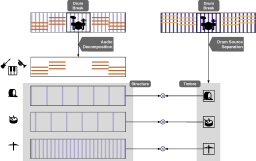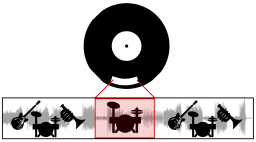Data/Code
Break-Informed Audio Decomposition for Interactive Redrumming

Link: Accompanying Website
Redrumming or drum replacement is used to substitute or enhance the drum hits in a song with one-shot drum sounds obtained from an external collection or database. In an ideal setting, this is done on multitrack audio, where one or more tracks are dedicated exclusively to drums and percussion. However, most non-professional producers and DJs only have access to mono or stereo downmixes of the music they work with. Motivated by this scenario, as well as previous work on decomposition techniques for audio signals, we propose a step towards enabling full-fledged redrumming with mono downmixes.
Finding Drum Breaks in Digital Music Recordings

Link: Accompanying Website
DJs and producers of sample-based electronic dance music (EDM) use breakbeats as an essential building block and rhythmic foundation for their artistic work. The practice of reusing and resequencing sampled drum breaks critically influenced modern musical genres such as hip hop, drum'n'bass, and jungle. While EDM artists have primarily sourced drum breaks from funk, soul, and jazz recordings from the 1960s to 1980s, they can potentially be sampled from music of any genre. In this paper, we introduce and formalize the task of automatically finding suitable drum breaks in music recordings. By adapting an approach previously used for singing voice detection, we establish a first baseline for drum break detection. Besides a quantitative evaluation, we discuss benefits and limitations of our procedure by considering a number of challenging examples.
Towards Modeling and Decomposing Loop-Based Electronic Music

Link: Accompanying Website
Electronic Music (EM) is a popular family of genres which has increasingly received attention as a research subject in the field of MIR. A fundamental structural unit in EM are loops – audio fragments whose length can span several seconds. The devices commonly used to produce EM, such as sequencers and digital audio workstations, impose a musical structure in which loops are repeatedly triggered and overlaid. This particular structure allows new perspectives on well-known MIR tasks. In this paper we first review a prototypical production technique for EM from which we derive a simplified model. We then use our model to illustrate approaches for the following task: given a set of loops that were used to produce a track, decompose the track by finding the points in time at which each loop was activated. To this end, we repurpose established MIR techniques such as fingerprinting and non-negative matrix factor deconvolution.
Mid-Level Audio Features Based on Cascaded Harmonic-Residual-Percussive Separation

Link: Accompanying Website
Harmonic-percussive separation is a technique that splits music recordings into harmonic and percussive components--it can be used as a preprocessing step to facilitate further tasks like key detection (harmonic component) or drum transcription (percussive component). We propose a cascaded harmonic-residual-percussive (HRP) procedure yielding a mid-level feature to analyze musical phenomena like percussive event density, timbral changes, and homogeneous structural segments. We first outline the steps to compute cascaded HRP features (CHRP) and then illustrate their capabilities by means of three examples: to visualize percussive and noise-like properties of snare-drum playing techniques, to examine changes between harmonic and percussive timbres in electronic music, and to identify homogeneous, purely percussive passages in funk and soul recordings (also known as breaks).

